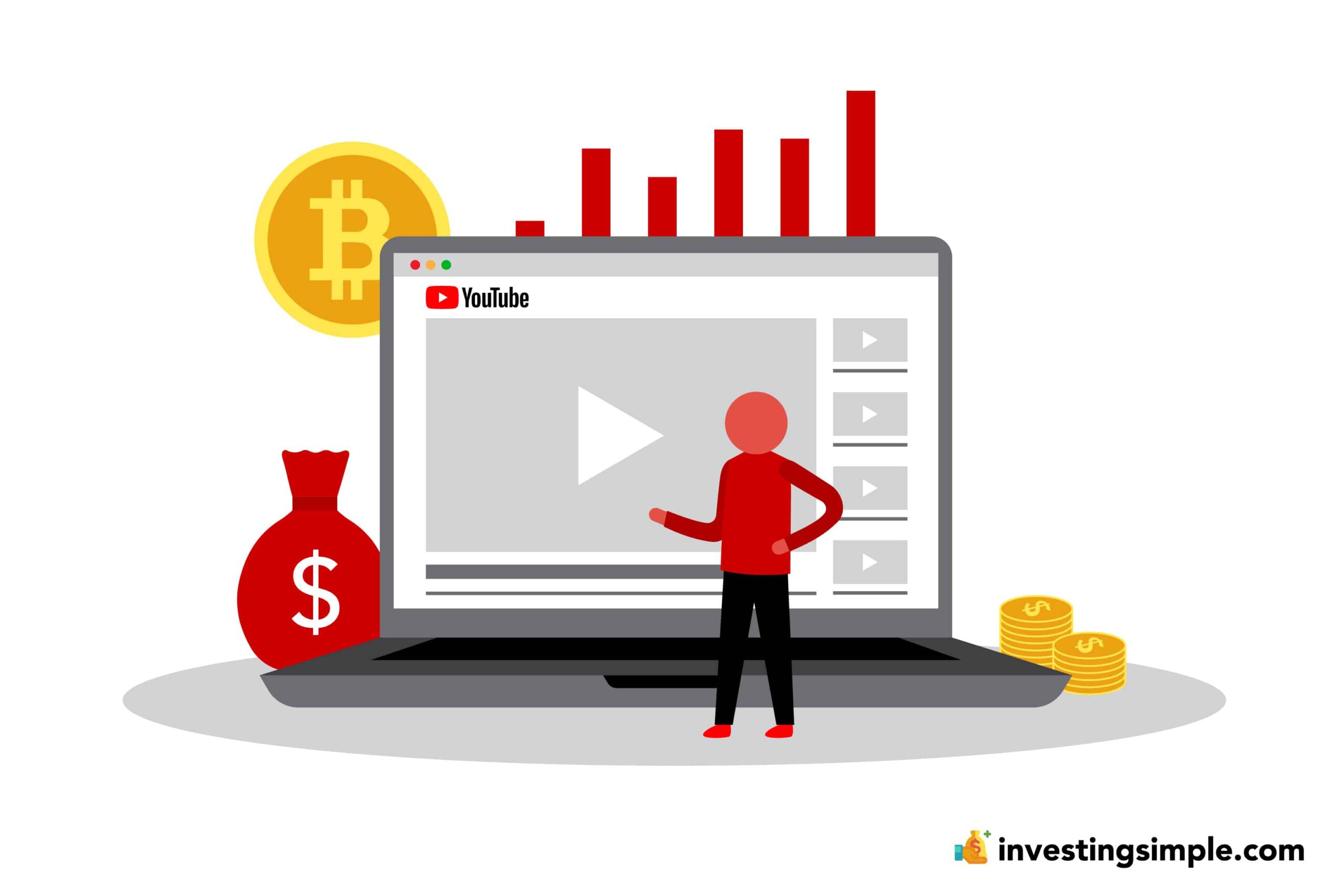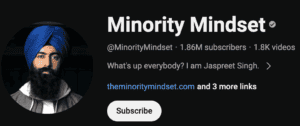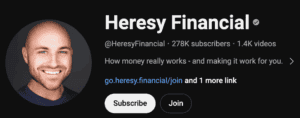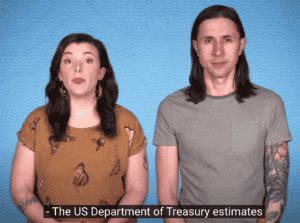





When you go on YouTube, what kinds of videos do you watch?
Most people think that YouTube is a place for watching funny cat videos, or checking out the highlights from America's Got Talent.
But over the last few years, there has been a massive shift in the type of content surfacing. Hundreds of money and finance related YouTube channels have popped up.
If you want to learn about money, real estate investing, stocks, credit score and more, YouTube is a fantastic place to do so.
Here's a list of 15 of the best Finance YouTube channels today.
Before we get into more details about these Finance YouTube Channels, it's important to keep a few things in mind when watching this content.
While these creators offer valuable educational content, viewers should remember that YouTube creators are not fiduciaries or licensed financial professionals unless specifically stated. Financial decisions should always be made in consultation with a certified planner or advisor who understands your unique goals and situation.
While some creators may be licensed professionals, it is best to assume they are not unless stated otherwise.
In addition, these creators represent a wide range of financial philosophies, and viewers should be mindful that "what's right" according to one creator may not be appropriate for their own situation.
Lastly, there is a somewhat obvious conflict here in regards to how these Finance YouTube Channels make money. Most finance YouTubers earn income through ad revenue, sponsorships, or affiliate links.
While many aim to provide unbiased education, there may be financial incentives behind certain product endorsements or topics covered. Always perform due diligence before acting on a recommendation.
In short, take everything said by a "Finfluencer" with a grain of salt, and don't assume they are experts.

Graham Stephan's YouTube channel focuses on personal finance, real estate investing, and entrepreneurship.
As a real estate investor and financial enthusiast, Graham shares his knowledge and experiences through informative and engaging videos. His content covers topics such as budgeting, saving money, investing in the stock market, and the intricacies of the real estate market.
Additionally, he offers insights into building credit, achieving financial independence, and the importance of passive income.
Graham's approachable style and practical advice have garnered him a large and dedicated following, making his channel a valuable resource for anyone looking to improve their financial literacy and build wealth.

Andrei Jikh's YouTube channel is dedicated to personal finance, investing, and financial literacy, with a strong focus on cryptocurrency and stock market investments.
Jikh combines his expertise in finance with a unique background in magic tricks, making his videos visually engaging and informative.
He offers insights into his own investment strategies, portfolio updates and financial decisions.
The channel is known for its transparent and approachable style, making complex financial topics accessible to a broad audience.

Meet Kevin, hosted by Kevin Paffrath, is a popular YouTube channel that primarily focuses on finance, real estate, and investing.
Kevin Paffrath, a real estate investor, entrepreneur, and licensed real estate broker, offers insights and advice on a wide range of financial topics. His videos cover stock market analysis, real estate investment strategies, personal finance tips, and updates on economic trends.
Kevin's content is known for its in-depth analysis, practical advice, and his ability to break down complex financial concepts into easily understandable information.
He often provides real-time market updates, discusses recent financial news, and shares his own investment strategies and experiences.
In addition to finance, he occasionally delves into political commentary, especially when it intersects with economic issues.
The channel has gained a large following due to Kevin's energetic presentation style, transparency about his own financial moves, and the actionable insights he provides.

Whiteboard Finance, created by Marko Zlatic, is a popular YouTube channel dedicated to personal finance, investing, and economic education.
The channel provides clear and concise explanations on a variety of financial topics, making complex concepts accessible to viewers of all levels of financial literacy.
Marko uses a straightforward and engaging teaching style, often incorporating visual aids like charts and diagrams to enhance understanding.
Marko Zlatic's background in finance and passion for educating others shine through in his content, making Whiteboard Finance a valuable resource for anyone looking to improve their financial knowledge.

The Minority Mindset YouTube channel, created by Jaspreet Singh, is dedicated to financial education and empowerment.
It offers a wide range of content focused on personal finance, investing, entrepreneurship, and economic insights.
The channel aims to help viewers break away from the traditional mindset and adopt a minority mindset that prioritizes financial literacy and independence.
Jaspreet provides in-depth explanations of various financial topics, such as stock market investing, real estate, cryptocurrency, and building passive income streams.
The channel frequently discusses current economic events and trends, analyzing their impact and providing strategies to navigate economic challenges.

Valuetainment is a popular YouTube channel founded by entrepreneur Patrick Bet-David.
Launched in 2013, the channel has grown to over 4 million subscribers, offering a blend of educational and motivational content primarily aimed at entrepreneurs and business enthusiasts.
Valuetainment's content covers a wide range of topics related to entrepreneurship, business strategy, and personal development.
The channel features in-depth interviews with high-profile figures such as Kobe Bryant, Mark Cuban, and President George W. Bush, providing viewers with insights into the experiences and strategies of successful individuals.
Additionally, Valuetainment includes motivational talks, how-to guides on various business aspects, and discussions on current economic events.
Valuetainment is praised for its high-quality production and valuable content, making it a go-to resource for those looking to enhance their business acumen and entrepreneurial skills.

The Joseph Carlson Show is a popular YouTube channel focusing on personal finance, investing, and wealth-building strategies.
Hosted by Joseph Carlson, the channel provides in-depth analysis of the stock market, individual stock performance, and overall investment strategies.
Carlson shares his own investment portfolio and updates, offering transparency and real-time insights into his financial decisions.
The content often includes discussions on economic trends, company earnings reports, and financial news, making it a valuable resource for both novice and experienced investors.
The channel's approachable style and educational focus have garnered a dedicated following, helping viewers make informed financial decisions.

Humphrey Yang's YouTube channel focuses on personal finance, investing, and financial education.
He simplifies complex financial concepts and provides practical advice on budgeting, saving, investing, and achieving financial independence.
His content includes in-depth explanations of financial instruments like stocks, bonds, and ETFs, as well as strategies for building wealth and managing money wisely.
Yang's approachable style and clear, concise explanations make his channel a valuable resource for both beginners and those looking to deepen their financial knowledge.
He also shares tips on navigating financial challenges and maximizing opportunities for financial growth.

The Plain Bagel YouTube channel is a popular platform dedicated to demystifying the world of finance and investing.
Created by Richard Coffin, a Chartered Financial Analyst (CFA), the channel aims to provide clear, straightforward explanations on various financial topics, making them accessible to a broad audience.
Richard covers a wide range of subjects, including stock market basics, economic principles, personal finance tips, and detailed analyses of financial instruments.
His approachable style, combined with well-researched content and engaging animations, helps viewers understand complex concepts with ease.

The Money Guy Show is a popular YouTube channel dedicated to personal finance, investing, and wealth building.
Hosted by Brian Preston and Bo Hanson, the channel aims to provide practical financial advice and insights to help viewers manage their money effectively and achieve financial independence.
The content on The Money Guy Show covers a wide range of topics, including budgeting, saving, investing, retirement planning, tax strategies, and real estate.
One of the standout features of the channel is its interactive and engaging format. The hosts frequently answer viewer questions, provide case studies, and discuss real-life financial scenarios.
The Money Guy Show also emphasizes the importance of long-term financial planning and disciplined investing. They advocate for strategies such as dollar-cost averaging, diversification, and maintaining a balanced portfolio.

Heresy Financial is a YouTube channel dedicated to providing insightful and highly detailed financial advice.
Hosted by Joseph Brown, the channel aims to educate viewers on personal finance, investing, economics, and the intricacies of the financial system.
Known for its straightforward and often provocative approach, Heresy Financial often challenges mainstream financial narratives.
Topics frequently covered include market analysis, precious metals, cryptocurrency, monetary policy, and tips for navigating economic uncertainties.

Two Cents is an educational YouTube channel that focuses on providing viewers with practical financial advice and economic insights.
The channel aims to make complex financial concepts accessible and engaging to a broad audience.
It covers a wide range of topics, including personal finance, investing, budgeting, economic theories, and the impact of current events on the economy.
The channel often uses animated videos to explain concepts in a visually appealing and easy-to-understand manner. It features hosts who break down financial topics with clarity, humor, and relatable examples, making it easier for viewers to grasp and apply the information in their daily lives.
Some popular video topics on Two Cents include tips for saving money, understanding credit scores, navigating student loans, and the basics of stock market investing.

The Dave Ramsey YouTube channel is a popular platform dedicated to personal finance education, hosted by financial expert Dave Ramsey.
Known for his straightforward and practical advice, Ramsey covers a wide range of financial topics, including budgeting, debt reduction, saving, investing, and wealth-building strategies.
The channel features segments from his radio show, "The Dave Ramsey Show," where he takes live calls from listeners seeking financial guidance.
Additionally, the channel offers insights into the principles of Ramsey's "Baby Steps" program, a step-by-step plan designed to help individuals achieve financial peace and independence.
Viewers can also find success stories from people who have followed Ramsey's advice and achieved significant financial milestones.

The Financial Diet is a popular YouTube channel dedicated to providing practical and relatable financial advice, especially aimed at millennials and young adults.
Created by Chelsea Fagan, the channel covers a wide range of topics related to personal finance, career development, and lifestyle. The content often includes budget tips, debt management strategies, investment advice, and discussions on frugal living.
The Financial Diet is known for its approachable and conversational style, making complex financial concepts accessible and engaging.
The channel also features interviews with experts, personal stories, and collaborations with other content creators to offer diverse perspectives on financial wellness.

Debt Free Millennials is a YouTube channel dedicated to helping millennials achieve financial independence and live a debt-free lifestyle.
The channel is run by Justine Nelson, who shares her personal experiences and practical advice on managing finances, paying off debt, and building wealth.
Content includes budgeting tips, debt repayment strategies, and ways to save money, as well as discussions on investing and side hustles.
While YouTube can be an excellent resource for learning about personal finance and investing, there are some common issues to watch out for. Here's how to avoid them:
Over-Simplified Advice
Many creators break down complex topics into easily digestible snippets. However, this can sometimes lead to oversimplification. Be cautious when following advice that seems too good to be true or doesn’t consider your unique financial situation. It's important to dig deeper into topics before applying them to your own finances.
FOMO (Fear of Missing Out)
Some channels encourage their viewers to act quickly or invest in hot stocks, real estate, or cryptocurrencies based on trends. While following financial advice from experts is valuable, remember that investing should be aligned with your personal goals and risk tolerance. Avoid making impulsive decisions based on hype or short-term trends.
Lack of Professional Guidance
While many YouTubers provide excellent advice, it’s important to remember that they are not financial advisors. Be careful about taking advice that’s specific to your financial needs without consulting a licensed professional. Consider using YouTube content as an educational supplement rather than a replacement for personalized financial planning.
Cherry-Picking Success Stories
Finance YouTube channels often highlight success stories of individuals who’ve made significant returns or achieved financial independence. While these stories can be motivating, they may not be representative of everyone’s journey. Be aware that the path to financial success varies greatly, and success doesn’t happen overnight.
Ignoring Long-Term Planning
Many channels focus on short-term wealth-building strategies or the latest trends, but it’s essential to maintain a long-term financial plan. Make sure you're balancing your desire for quick returns with a sustainable approach that includes retirement planning, emergency savings, and debt management.
By staying informed, being critical of the content you consume, and focusing on long-term financial goals, you can avoid the common pitfalls that come with following finance YouTube channels.
When it comes to learning about personal finance and investing, YouTube provides a modern, accessible alternative to traditional financial education. There are many benefits (and a few downsides) of learning finance on YouTube:
Accessibility and Convenience
YouTube offers unparalleled convenience. You can watch content at your own pace, anytime and anywhere, without the need for a formal classroom setting. Traditional financial education, such as university courses or certifications, often requires a larger time commitment and financial investment, while YouTube allows for free, on-demand learning.
Diverse Perspectives
One of the greatest advantages of YouTube is the wide range of perspectives available. You can find content from people of all walks of life, from experienced investors to entrepreneurs and financial experts. This diversity can help you see different approaches to managing money. In contrast, traditional financial education may offer more structured content, but it often lacks the flexibility to explore alternative methods or insights from a broad variety of real-world experiences.
Depth of Knowledge
Traditional financial education tends to provide a deeper, more academic understanding of complex financial topics, especially for those pursuing advanced degrees or certifications. These courses often cover foundational knowledge, theories, and regulations that are necessary for working in finance professionally. YouTube channels, while great for practical, real-world tips, may not delve into the depth required for high-level financial careers or nuanced investment strategies.
Quality Control
YouTube's content is not regulated, meaning the quality of advice can vary widely. Some channels provide well-researched, evidence-backed financial information, while others may lack credibility or spread misinformation. In contrast, traditional education institutions follow a curriculum designed by experts and are subject to accreditation, ensuring a higher standard of education and greater reliability.
Interactivity and Engagement
YouTube offers a level of interactivity and engagement that traditional education often cannot match. Channels frequently engage with their audiences through comments, live Q&A sessions, and polls, creating a community feel. Traditional education can be more rigid, with less immediate feedback, although it offers networking opportunities and access to mentors in the professional world.
Cost
One of the most significant advantages of YouTube over traditional financial education is the cost. YouTube offers nearly all of its content for free, whereas traditional financial education comes with a hefty price tag—whether it's the cost of university tuition, professional certification exams, or financial planning courses.
The best approach is often to use YouTube as a supplement to more formal education or professional advice.
As YouTube continues to evolve, so too does the type of content available in the finance space. Soon, YouTube and finance content may be completely different than what it is now.
Increased Specialization
As personal finance becomes a more prominent focus for creators, we’ll likely see an increase in specialized finance channels. These channels will cater to specific niches such as retirement planning, debt management, cryptocurrency, or even sustainable investing. We are already seeing these specialized channels pop up!
AI-Driven Financial Content
With advances in artificial intelligence, it’s possible that we’ll start to see AI-generated finance content or tools that help personalize financial advice. For example, AI algorithms could analyze a viewer’s financial situation and recommend tailored content that best suits their needs. This level of customization will make YouTube even more effective for personal finance education.
More Collaboration with Financial Institutions
As YouTube continues to grow as a platform for finance education, we may see more collaborations between finance creators and established financial institutions. This could lead to partnerships where creators offer exclusive insights, educational programs, or tools designed in conjunction with banks, investment firms, and other financial entities. Some partnerships have been forged, but many of them are with shady crypto businesses instead of legit institutions.
Increased Regulation and Standardization
As the financial landscape becomes more saturated with content, YouTube may implement stricter regulations to ensure the accuracy and credibility of financial advice (similar to what we are seeing on X.com with 'community notes'). Financial creators might need to provide disclaimers or certifications to verify their qualifications, ensuring that viewers receive reliable and responsible information.
Rise of Subscription-Based Financial Content
While YouTube’s ad-driven model will remain dominant, there’s also the potential for a rise in paid subscription-based financial content. Creators can already offer exclusive content behind paywalls, providing premium access to in-depth financial education, tools, software, or one-on-one advice. The hope is this paywalled experience will be substantially better than the free content.
Overall, the future of finance content on YouTube looks bright, with greater specialization, increased interactivity, and potential collaborations with the financial industry.